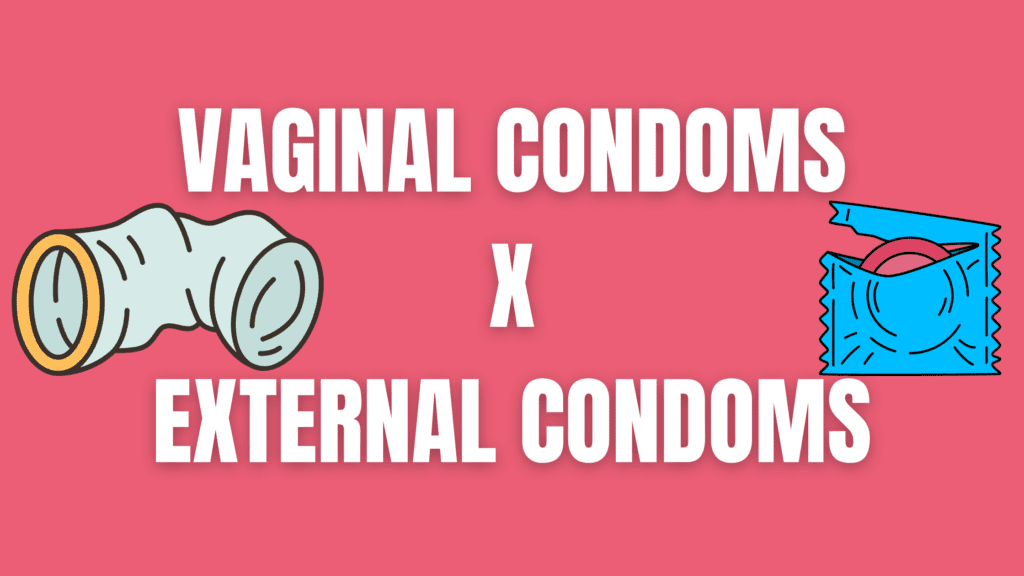When it comes to contraception and safer sex, condoms remain one of the most reliable and accessible options. But did you know there are two main types of condoms, vaginal condoms and external condoms? While both serve the purpose of preventing unintended pregnancies and reducing the risk of sexually transmitted infections (STIs), they are quite different in their design, usage, and benefits. This blog dives deep into everything you need to know about vaginal condoms and external condoms, so you can make informed choices for your sexual health.
What Are Vaginal Condoms?
Vaginal condoms, also called internal condoms or female condoms, are barrier devices worn inside the vagina or anus during sexual intercourse. They are designed to block sperm from entering the uterus and protect against STIs.
How Do They Work?
Vaginal condoms are made of a soft, flexible material such as nitrile or polyurethane. They have two rings:
- Inner Ring: This smaller ring is inserted into the vagina to hold the condom in place.
- Outer Ring: The larger ring stays outside the vaginal opening and covers part of the vulva.
Once in place, the vaginal condom acts as a barrier between partners during sex.
Benefits of Vaginal Condoms
- Dual Protection: Prevents both pregnancy and STIs.
- Allergy-Friendly: Latex-free, making them suitable for those with latex allergies.
- Empowers the Wearer: Gives more control to the person wearing it, as they can insert it before sex.
- Versatility: Can also be used for anal sex.
- Heat Transfer: Offers a natural-feeling experience because it transfers body heat.
Drawbacks of Vaginal Condoms
- Practice Required: May take a few tries to learn proper insertion.
- Availability: Not as widely available as external condoms.
- Cost: Often more expensive than external condoms.
What Are External Condoms?
External condoms, commonly referred to as male condoms, are barrier devices worn over an erect penis during sexual activity. They are the most popular form of contraception and STI prevention worldwide.
How Do They Work?
External condoms are typically made of latex, though there are non-latex options like polyurethane or polyisoprene for those with allergies. They create a physical barrier, preventing sperm from entering the vagina, anus, or mouth during sex.
Benefits of External Condoms
- Widely Available: Can be purchased in most stores, pharmacies, and even vending machines.
- Cost-Effective: Affordable and sometimes available for free at health clinics.
- Easy to Use: Simple to put on with minimal practice.
- Variety: Available in different sizes, textures, flavors, and even lubricated or non-lubricated options.
Drawbacks of External Condoms
- Allergy Risk: Latex condoms may cause irritation for some users.
- Breakage or Slippage: If not used correctly, external condoms can tear or slip off.
- Requires Consistency: Must be used every time to be effective.
Key Differences Between Vaginal and External Condoms
| Feature | Vaginal Condoms | External Condoms |
| Placement | Inserted inside the vagina or anus | Worn over an erect penis |
| Material | Nitrile or polyurethane | Latex, polyurethane, or polyisoprene |
| Control | Worn by the receptive partner | Worn by the penetrative partner |
| STI Protection | Provides broad STI protection | Effective against STIs, but less vulva coverage |
| Ease of Use | Requires practice for insertion | Easy to put on with guidance |
| Availability | Limited in stores, more online | Widely available everywhere |
Common Myths About Condoms
Myth 1: Vaginal Condoms Are Less Effective
Fact: When used correctly, vaginal condoms are just as effective as external condoms in preventing pregnancy and STIs.
Myth 2: External Condoms Are Uncomfortable
Fact: Modern external condoms come in ultra-thin materials that offer a natural feeling. Proper sizing also ensures comfort.
Myth 3: Condoms Reduce Pleasure
Fact: Both vaginal and external condoms are designed to enhance safety without sacrificing pleasure. Using lubricated options or experimenting with textures can improve the experience.
How to Choose the Right Condom
- Evaluate Your Needs: If you prefer control over your contraception, a vaginal condom might be the better choice. If you’re looking for convenience, an external condom is ideal.
- Check for Allergies: Opt for latex-free options if you or your partner has a latex allergy.
- Practice Makes Perfect: Whether it’s inserting a vaginal condom or rolling on an external one, practice ensures effective use.
- Consult a Healthcare Provider: If you’re unsure which condom suits you, don’t hesitate to ask a healthcare professional.
Final Thoughts
Whether you opt for vaginal condoms or external condoms, the most important factor is consistent and correct use. Both are effective methods to prevent pregnancies and STIs, and having the choice empowers individuals to take control of their sexual health.
If you’re new to vaginal condoms, give them a try and see if they work for you. And if you’re sticking to external condoms, make sure to experiment with different types to find your perfect match.
Remember, using condoms is a responsible and proactive step toward a healthier and more enjoyable sex life.

